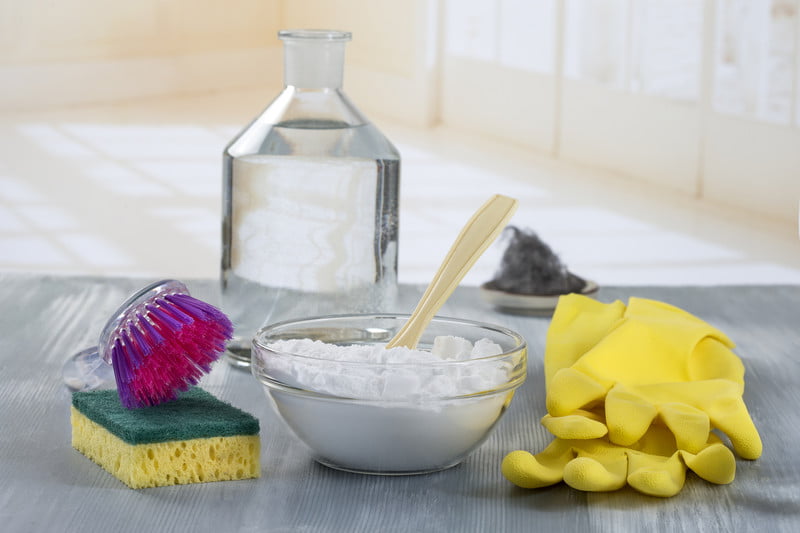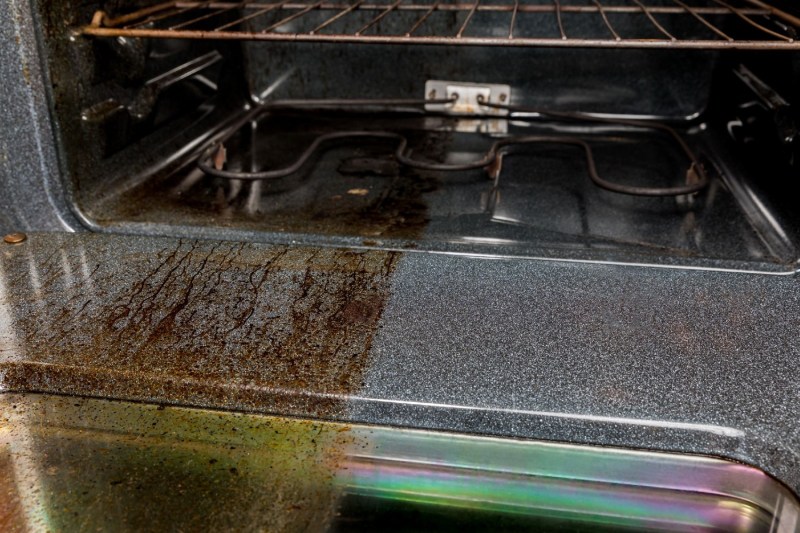
Let’s be real. When it comes to household chores and responsibilities, cleaning oven racks falls pretty low on the fun-to-do list. It’s messy, it’s greasy, and it tests the line of needing to be a circus contortionist in order to reach all those dark, dingy corners.
But it’s a task that simply must be done. A dirty oven can actually affect the taste of your food, and if the situation is dire (no judgment here), even lead to food poisoning in certain cases. So, as grimy and gruesome as the chore can be, it’s an important one to conquer. Just think of how rewarding a squeaky-clean oven will be and about all the delicious casseroles waiting to be prepared and enjoyed, a testament to your efforts.
You may be asking yourself how to clean oven racks. So grab a sponge — and maybe a drink — and get ready to get dirty.
Vinegar, baking soda, bathtub method

Please note: This is an overnight method so make sure to set some time aside.
- Remove the oven racks and place them in your tub, and then cover them lightly with baking soda.
- Next, add vinegar and ensure it is coating the entire surface of your rack. Do not be surprised when the racks start to foam. This is a chemical reaction that is doing most of the hard scrubbing work for you.
- After the foaming stops, cover the racks with hot water and let them soak overnight.
- In the morning, use an old scrap of fabric to wipe down the racks and remove any excess grease or baked-on grime. If you are having trouble, applying coarse sea salt and further scrubbing should help.
Dish soap, towels, sponge, and bathtub method

For this technique, you will need powdered dish soap, old towels, some sponges, and your bathtub to handle the task.
- Begin by placing old towels on the bottom of your bathtub so as to protect it from being scratched by your oven racks. Next, add your oven racks to the tub. Cover them with warm water and add a cup of your favorite dishwasher powder.
- Let the mixture sit overnight, and in the morning, use an old sponge to wipe off any excess grease or grime that is still caked on your oven racks.
- After you are satisfied, clean and rinse out the tub, and you are all set.
Commercial oven cleaning products

When faced with a particularly challenging and tough situation, you can count on commercial oven cleaning products. The only problem with this method is that these products are extremely corrosive and toxic, so you will want to be careful not to allow these cleaning products to get near the food you eat or other people. It is also important to use these products in a well-ventilated area. The fumes from commercial oven cleaners can make you, your pets, and your family very sick.
To use this method, cover a space on your floor, maybe outside on a patio or in a garage with an open door with some newspaper or a drop cloth. Place the racks on top of this work surface. Next, use rubber gloves to ensure no commercial oven cleaner gets on your skin, then spray the cleaner on both sides of the oven racks.
Allow the cleaning solution to sit for at least 10 minutes, though you should give precedence to the instructions printed on the label of the product. Finally, use an old rag to wipe off excess chemicals, and then spray the rags with a hose or faucet thoroughly before putting the racks back in your oven. Follow any additional instructions provided by the oven cleaner’s manufacturer.
FAQs

How often should I clean my oven rack?
Cleaning your oven rack should be done at least four times a year, though if you cook most of your meals at home in your oven, we recommend increasing that to as often as once a month. As an added bonus, whenever you do maintenance cleaning tasks like this more frequently, the actual work becomes much easier and more manageable to handle.
Can I use the self-cleaning function on my oven?
Most modern ovens have a self-cleaning function built right in, and it can be very tempting to use it and call it a day, right? Wrong! Your oven’s self-cleaning function uses extremely high heat to work and risks damaging the shiny chrome metal of your oven rack and the internal components of the appliance itself.
Experts recommend only using the self-cleaning function after you’ve already used one of the methods listed in this guide to remove excess grease and food. So, to answer your question: Yes, you can definitely use the self-cleaning function of your oven, but only after you’ve cleaned it manually.
What are more oven rack cleaning tips?
Here are some more helpful tips to make cleaning your oven racks a breeze and not such a big job when it’s time to do it.
- Work before the mess gets out of hand: The sooner you tackle burnt-on grime, the easier it will be to remove. Don’t wait until they’re caked on!
- Let the cleaning agent do the work: When using baking soda or oven cleaner, allow sufficient soaking time. This loosens the grime significantly, minimizing your scrubbing effort.
- Rinse thoroughly: After cleaning, rinse the racks well with hot water to remove any cleaning residue or food particles.
- Dry completely: Don’t put wet racks back in the oven. Use a clean dish towel or let them air dry completely to prevent rust.
- Consider laying down protection: When working outside the oven, lay down some newspaper or an old towel to catch drips and spills.



